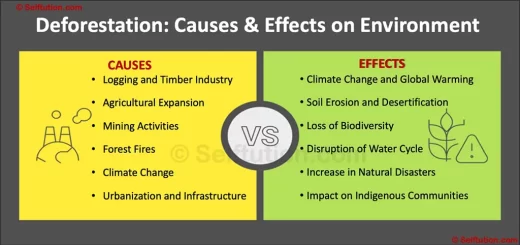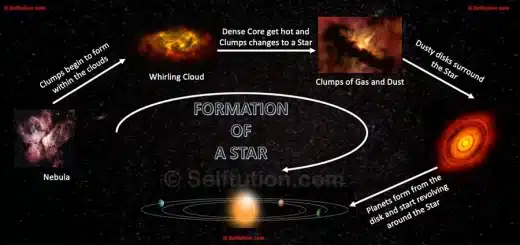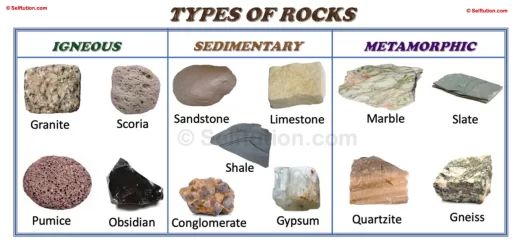Types of Rocks – Igneous, Sedimentary & Metamorphic
Rocks are the building blocks of our planet, and understanding their different types helps unlock the mysteries of Earth’s history. Rocks can be classified into three primary types: igneous, sedimentary, and metamorphic.
Each rock type forms through unique processes, telling a story of intense heat and pressure, gradual erosion, or dramatic transformation.
This post will explore their characteristics, formation processes, locations, and geological significance. But before we proceed with the study of types of rocks, it is important to know what a rock is.
What is Rock?
A rock is a hard, solid material found on the Earth’s surface. It’s made up of minerals, which are natural substances with specific chemical compositions. When minerals or earthly particles like clay, sand, shale, magma, etc., combine to form a bigger particle, we call it a rock.
Rocks come in different shapes, sizes, and colors. They can be small like pebbles or huge like mountains. Imagine being told that our planet Earth is merely a colossal rock. Would you believe it? Well, it’s true! Earth is frequently described as the third rock from the sun.

The Earth – The biggest rock in our solar system
Rocks are important because they tell us a lot about the Earth’s history and how it has changed over time. They form through different processes like cooling from molten lava, layering of sediment, or intense pressure and heat deep within the Earth. Minerals or earthly particles don’t always combine in fixed ratios or structures to create a rock. As a result, we can’t describe rocks with a fixed chemical composition or formula
Definition of Rock –
Rock is an agglomeration of minerals and earthly particles like clay, sand, shale, and magma.
The scientific study of rocks is known as petrology, with “petro” meaning “rock” and “logy” meaning “study”.The study of rocks provides a record of the passage of time and the evolution of living things on Earth.
Types of Rocks
Now that we’ve grasped the concept of what rocks are, let’s dive deeper into understanding their various types: igneous, sedimentary, and metamorphic.
IGNEOUS ROCKS
What is Igneous Rock?
Igneous rocks form when hot, molten rock, called magma or lava, cools and solidifies. This process occurs deep underground or on the Earth’s surface during volcanic eruptions. As magma rises toward the surface, it encounters different levels of pressure and temperature. Deep within the Earth, where pressure is high and temperatures are extreme, the magma cools slowly over thousands to millions of years, allowing large crystals to form. This process produces intrusive igneous rocks like granite.
In contrast, when lava erupts onto the surface, it cools rapidly due to lower pressure and temperature, forming small or no crystals. This rapid cooling results in extrusive igneous rocks like basalt. The texture and appearance of igneous rocks are thus influenced by the speed of cooling, which in turn is affected by pressure and temperature. Studying these rocks provides valuable insights into Earth’s geological processes and history.
Igneous rocks make up approximately 95% of the Earth’s crust. Other rock types, such as sedimentary and metamorphic, stem from igneous rocks, earning them the title of primary rocks. Numerous igneous rocks exist, each characterized by distinct minerals and structures.
To learn more about igneous rocks, please watch this wonderful video by ClickView. Video courtesy ClickView
Types of Igneous Rocks
There are over 700 types of igneous rocks. Examples include granite, scoria (also known as basalt), pumice, and obsidian
Granite rocks
Granite, a common igneous rock, forms deep underground from slowly cooling magma. It’s composed mainly of quartz, feldspar, and mica minerals, giving it a speckled appearance. Renowned for its durability, granite is widely used in construction, particularly for countertops and building facades, due to its strength and resistance to weathering. Its varied colors and patterns enhance architectural designs, making it a popular choice. With its natural beauty and longevity, granite remains a cherished material in both residential and commercial settings.
Scoria or Basalt rocks
Scoria rock, also known as basalt rock, forms due to the quick cooling of lava during underwater volcanic eruptions in the sea or ocean. It is not a mixture of minerals; rather, it is a type of glass. It features small pits caused by the release of air from small pockets during its formation. Abundant in volcanic regions, scoria’s porous texture makes it lightweight and suitable for various construction applications, including concrete aggregate and road surfaces. Additionally, its dark color and rough surface make it a popular choice for landscaping and decorative purposes.
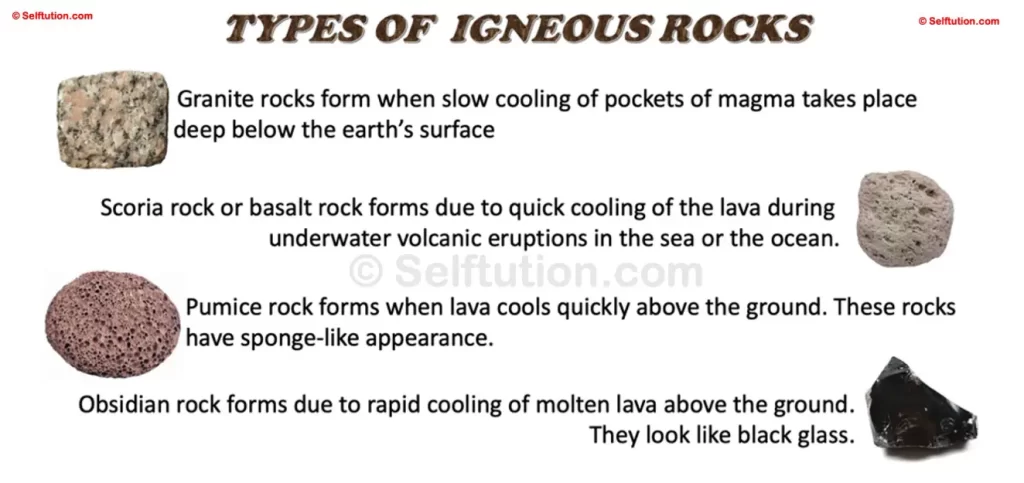
Prominent types of igneous rocks and the processes underlying their formation
Pumice rocks
Pumice is a lightweight, porous igneous rock formed from frothy lava. Its unique texture results from the rapid cooling and solidification of lava containing high levels of gas, creating countless tiny air pockets within the rock, giving it a spongy appearance. Due to its low density, pumice can float on water. We use powder of pumice rocks to make soaps, tooth powder, and polish floors. Additionally, its ability to retain moisture makes it useful in horticulture for improving soil drainage.
Obsidian or Volcanic rocks
Obsidian, also known as volcanic glass, forms from rapidly cooled lava. It’s dark and glossy, often black or dark brown, with a smooth texture. Obsidian lacks a crystal structure due to its rapid cooling process, distinguishing it from other rocks. Ancient peoples crafted sharp tools and weapons from obsidian due to its sharp edges when fractured. Today, it’s prized for jewelry and ornamental objects. Obsidian isn’t as common as other rocks, typically found in areas with recent volcanic activity.
Back to Types of Igneous Rocks
SEDIMENTARY ROCKS
What is Sedimentary Rock?
Sedimentary rocks are created through the accumulation and compression of sediments over extended periods. These sediments, such as sand, mud, and organic matter, settle in layers on the Earth’s surface. As more layers accumulate, the weight of the overlying sediments compresses the lower layers, causing them to harden into rock. Over millions of years, these processes result in the formation of sedimentary rocks.
Chemical processes such as precipitation and evaporation also play a role in forming sedimentary rocks. These rocks frequently contain fossils, offering important insights into ancient environments and organisms. Sandstone, limestone, and shale are sedimentary rocks, each with unique features.
While these rocks comprise only about 5% of the Earth’s crust, surprisingly, sedimentary rocks cover approximately 75% of the land surface.
Types of Sedimentary Rocks
There are many types of sedimentary rocks. A few examples of sedimentary rocks are sandstone, limestone, conglomerate, gypsum, and shale.
Sandstone rocks
Sandstone rocks form due to the deposition of sand at the bottom of rivers, lakes, and oceans. They are rich in minerals called quartz and feldspar. Sandstone is soft, either yellow, brown, red, or pink. As it is relatively soft to carve, people around the world widely use it for the construction of buildings, statues, and temples. The Red Fort in Delhi is constructed from red sandstone. Sandstone’s grainy texture and ability to hold water make it valuable for construction and decorative purposes. Additionally, sandstone often contains fossils, providing valuable insights into ancient environments and life forms.
Limestone rocks
Limestone is a sedimentary rock formed from the accumulation of calcium carbonate (calcite) deposits over time. Calcite often originates from the remains of marine organisms like shells and coral. Limestone typically appears in shades of white, beige, and gray, and its texture can range from coarse to fine. This versatile rock is widely used in construction for buildings, roads, and sculptures due to its durability and ease of shaping. Additionally, limestone plays a vital role in industries such as agriculture, as a soil conditioner, and in the production of cement. Chalk, utilized for writing on blackboards, is also a form of limestone.
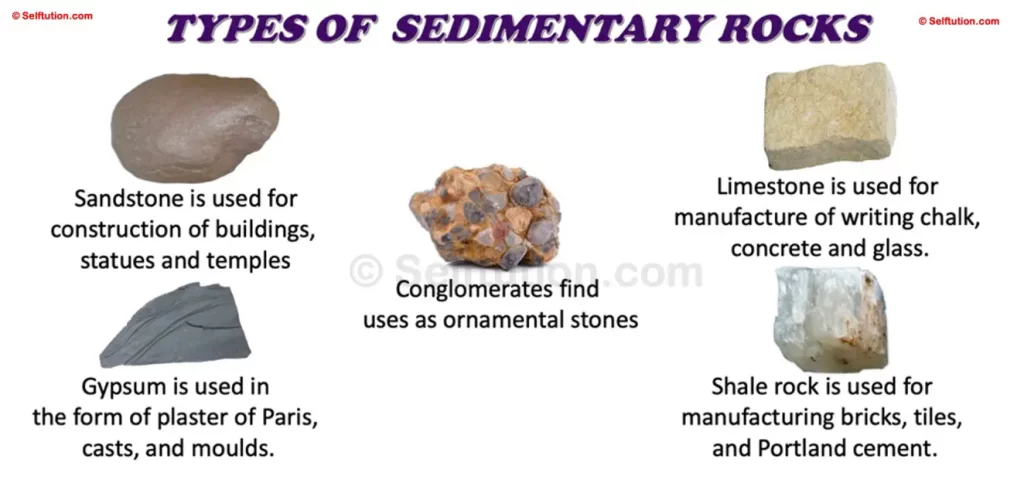
Types of sedimentary rocks and their practical applications
Conglomerate rocks
Sedimentary rocks form conglomerate rocks through the compression and cementation of rounded gravel and pebble-sized particles. They often contain a mix of different materials, such as sand, clay, and larger rocks, all bound together by a natural cement. Conglomerates have a coarse texture and typically appear in various colors, depending on the composition of the particles. Because of their strength and durability, people commonly use conglomerate rocks in construction for buildings, walls, and pathways.
Gypsum rocks
Gypsum rock is a soft mineral found in the Earth’s crust, often white or gray. We can use it in many ways, like making drywall for building house walls and improving soil quality in agriculture. Gypsum typically forms within layers of sedimentary rock, often accumulating in thick beds. Its formation occurs predominantly in lagoons, where the gradual evaporation of ocean waters rich in calcium and sulfate allows for replenishment over time. Besides drywall, gypsum is used in plaster, casts, molds, and various industries.
Shale rocks
Shale rocks, often occurring in sheets several meters thick, constitute approximately 70% of the sedimentary rocks in the Earth’s crust. They are created through the compression of silt and clay, gradually layered under immense pressure. Shale is usually gray or black and breaks easily into thin layers. People use shale for various purposes, including making bricks and tiles, and even as a source of natural gas. Shale formations can also hold oil and gas deposits, making them important for energy production. Overall, shale rock plays a significant role in the construction and fuel industries.
Sedimentary Rocks – Layers of Time
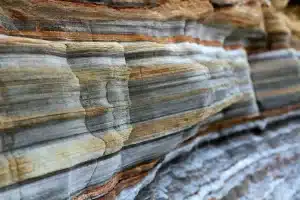
The vertical Section of sedimentary rock depicting various layers deposited over time
Sedimentary rocks form in horizontal layers across various environments, including the seabed, lakebeds, riverbanks, and even deserts, where sandstone emerges. These layers serve as a timeline, accumulating over millions of years. Fossils, exclusive to sedimentary rocks, provide a glimpse into ancient life forms. However, during the transformation into igneous or metamorphic rocks, fossils can be obliterated. Earth’s forces bend and fold sedimentary rocks over time, while erosion shapes them into particles, which eventually contribute to future sedimentary formations.
METAMORPHIC ROCKS
What is Metamorphic Rock?
Metamorphic rocks undergo metamorphosis, a natural process of complete change without melting. Consequently, they emerge as rocks transformed by pressure, intense temperature, or the interaction of water and chemicals. These rocks originate from former sedimentary or igneous rocks. The transformation occurs deep within the Earth’s crust, where immense pressure and heat alter their texture and mineral composition. This process often leaves behind flattened grains in metamorphic rock samples, offering evidence of their profound metamorphic journey. Thus, metamorphic rocks serve as tangible records of Earth’s dynamic forces and the enduring process of geological transformation.
Marble, for example, originates from limestone, while slate forms from shale. Metamorphic rocks occur in mountain ranges and regions where tectonic plates collide. While they don’t usually contain fossils, they provide valuable clues about Earth’s history and the powerful forces that shape its surface. Overall, metamorphic rocks are a testament to nature’s transformative power.
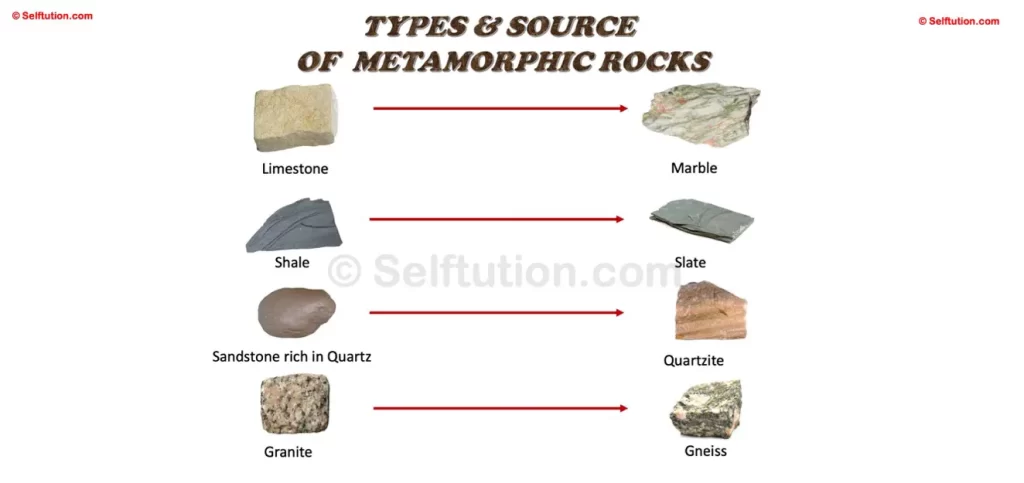
Examples of source rocks and their resulting metamorphic rocks
Types of Metamorphic Rocks
There exist numerous types of metamorphic rocks, each showcasing distinct characteristics, textures, and mineral compositions, as exemplified below
Marble
Marble, a metamorphic rock, originates from limestone, a sedimentary rock. Limestone forms when calcium carbonate precipitates from water or organic debris accumulates. Marble, known for its elegant appearance, typically appears white or light-colored and often features beautiful veining patterns. It comes in various colors beyond white and black. Used in buildings and sculptures, marble’s durability and beauty shine. The Taj Mahal in Agra, India, stands as a prime example, its grandeur showcasing the exquisite nature of white marble in architectural marvels.
Slate
Slate, a metamorphic rock, originates from shale, a sedimentary rock, transformed through heat and pressure. It possesses a shiny appearance and can be easily split into thick sheets. Typically gray or black, slate finds various applications, including making blackboards, roofs, and stone walls. Its durability and versatility have made it a favored material for centuries, valued for its ability to endure and its aesthetic appeal in both practical and decorative contexts.
Quartzite
Quartzite, a robust metamorphic rock, originates from sandstones rich in quartz. It typically appears white or gray and may contain streaks of other colors. Renowned for its durability and resistance to weathering, quartzite finds usage in construction for countertops, tiles, and as a decorative stone. Its hardness makes it suitable for various applications, including statues, where its enduring nature ensures longevity and aesthetic appeal.
Gneiss
Gneiss, a durable metamorphic rock, forms from granite, an igneous rock. Mineral grains within gneiss become flattened and arranged in alternating patterns, creating distinctive banding. These rocks are often glittery due to the presence of mica, a shining mineral. As gneiss comes in various colors, including gray, pink, and white, therefore, we use it for construction materials like countertops and paving stones.
In conclusion, understanding the types of rocks—igneous, sedimentary, and metamorphic—provides insight into Earth’s dynamic processes. Igneous rocks originate from molten magma, sedimentary rocks form through the accumulation and cementation of sediments, while metamorphic rocks transform under heat and pressure. Each type offers clues about Earth’s history, environmental conditions, and geological forces. From the majestic peaks of granite mountains to the delicate layers of limestone cliffs, rocks shape our landscapes and reveal the story of our planet’s evolution. By studying these diverse formations, we gain a deeper appreciation for the intricate processes that have shaped our world.
